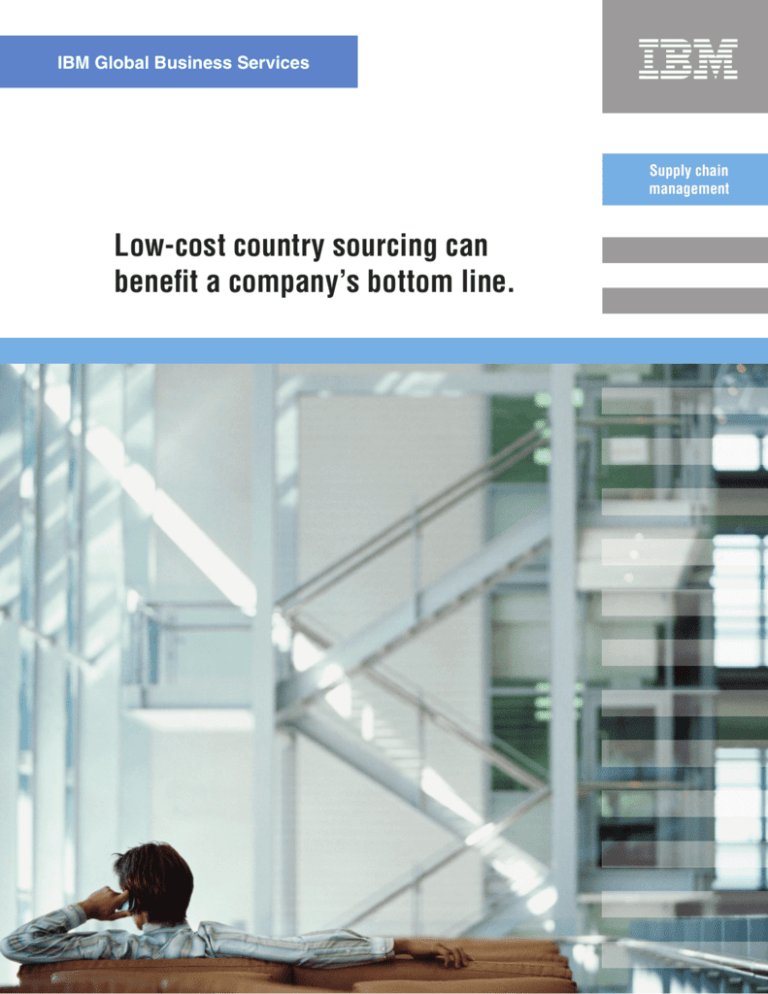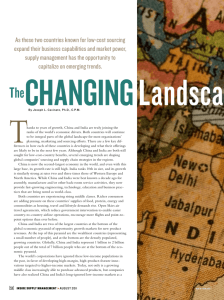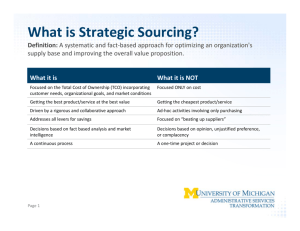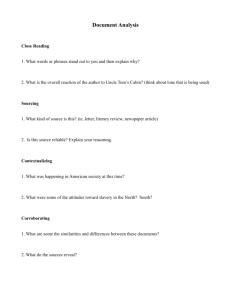
IBM Global Business Services
Supply chain
management
Low-cost country sourcing can
benefit a company’s bottom line.
IBM Global Business Services
Page IBM Global Business Services
Page Contents
3 Executive summary
3 Low-cost country sourcing
helps grow revenue
7 Other benefits from low-cost
country sourcing
7 Low-cost country sourcing is
becoming a common strategy
9 The potential downsides of low-
Executive summary
Companies can realize significant direct material savings — up to 40 percent or more in purchase price1 — when they successfully access and
rely on low-cost sources in emerging regions. This white paper describes
the bottom-line and competitive benefits companies can derive from
using low-cost manufacturing sources. It also describes the risks companies face and some ways to keep those risks at manageable levels when
they work with suppliers in low-cost countries around the globe. Finally, it
outlines five best practices companies should employ when working with
low-cost country suppliers.
cost country sourcing
9 Overcoming risks
12 Key low-cost country sourcing
considerations for a chief
procurement officer
14 Five best practices for low-cost
country sourcing success
15 Low-cost country sourcing can
deliver tangible results to the
Low-cost country sourcing helps grow revenue
Revenue growth. That’s the number one priority for four out of five CEOs.2
CEOs seeking revenue growth must often reduce costs to maintain or
expand profit margins. Both tasks are made more challenging when
customer demand changes on a whim, supply chains are interrupted,
costs for materials increase unexpectedly and the competitive landscape
morphs apparently inexplicably.
bottom line
The following countries are typically considered to be emerging markets
which are offering a low-cost environment:
• China
• Thailand
• Vietnam
• India
• Ukraine
• Romania
• Bulgaria
• Mexico
• Brazil
IBM Global Business Services
Page Implementing sourcing programs in economically emerging regions like
Asia-Pacific, Eastern Europe and Latin America is one way for a company to grow revenues. That’s because, by sourcing goods in the local
market, a company can compete more effectively and expand its business. Additionally, low-cost country sourcing can provide reduced cost for
a company’s global factory network as well. In fact, a company sourcing
materials or products from a low-cost region can improve its bottom line by
reducing its purchase price up to 40 percent3 or more. (See Chart 1.)
Highlights
Sourcing in low-cost countries
helps companies to improve their
competitivemess.
Savings of up to 40% on purchased
goods can be realized.
Chart 1: Range of sourcing savings for selected spend categories
+IJTMIVL
PIZVM[[
-TMK\ZWVQK[
IVLI[[MUJTa
5MKPIVQK[
<WWTQVO
5QV;I^QVO[
5I`;I^QVO[
8TI[\QK[
Source: IBM Integrated Supply Chain analysis
Savings generally result from low labor and infrastructure costs, as well
=;%
as capitalizing on the growing and highly competitive marketplaces for
subcomponents in these regions. And those savings present compelling
!
reasons for companies
to migrate manufacturing operations to low-cost
areas.
Low labor costs are a primary driver of the substantial savings companies can experience. Chart 2 illustrates the dramatic differences in labor
costs between regions. The hourly costs for labor in China and Mexico,
for example, are substantially lower than in North America and Western
Europe.
=VQ\ML -= 2IXIV
;\I\M[
)[QIV
61-[
*ZIbQT
5M`QKW :WUIVQI +PQVI
IBM Global Business Services
Page +IJTMIVL
PIZVM[[
-TMK\ZWVQK[
IVLI[[MUJTa
5MKPIVQK[
<WWTQVO
5QV;I^QVO[
5I`;I^QVO[
8TI[\QK[
Highlights
Determination of net savings should
include consideration of all additional
costs (e.g. transport, duties) on top of
Chart 24: Average hourly compensation costs of manufacturing workers, selected
economies and regions, 2002
=;%
the component price.
!
Comparison of labor rates between
mature economies and low cost coun­
tries shows significant opportunities
for savings.
=VQ\ML -= 2IXIV
;\I\M[
)[QIV
61-[
*ZIbQT
5M`QKW :WUIVQI +PQVI
Citation: Manufacturing earnings and compensation in China. Judith Banister, Monthly Labor Review,
August 2005
1
2
EU(15) are the European Union member countries prior to the expansion to 25 countries on May 1, 2004.
Asian NIE’s are the newly industrialized economies of Hong Kong, Korea, Singapore, and Taiwan.
Source: Bureau of Labor Statistics, “International comparisons of hourly compensation costs for production workers in manufacturing,1975–2003,” Nov. 18, 2004; on the Internet at http://www.bls.gov/fls/home.
htm. For China, data are from this article and not from the BLS series. The data for China refer to all
employees rather than just production workers. Hourly compensation for Romania in 2002 as per Eurostat
website: http://epp.eurostat.cec.eu.int.
But labor is only one element in the total cost of a component’s price.
To determine the total cost, a company must include the component’s
manufactured price plus shipping costs, customs charges and other
expenses involved with moving a component from the manufacturer to
the point where it’s incorporated in the final product.
If, for example, the cost basis is 100 points for a component manufactured in Germany and 70 points for the same component manufactured
in China, the gross savings is 30 points. Shipping the component to
Germany and customs charges may add another 10 points, bringing the
component’s total cost to 80 points. The net savings of 20 points may
still be enough to warrant sourcing that component in China.
IBM Global Business Services
Page Highlights
Procurement savings can significantly
influence bottom-line results.
Significantly greater revenue increases
are required to net comparable bottom
line impact.
Procurement savings can make a direct contribution to a company’s bottom
line, compared to other methods for improvement. Chart 3 illustrates that for
a company in the electronics industry, every procurement dollar saved may
go directly to the company’s bottom line. To otherwise achieve the same
impact, the company must increase revenue 29 percent.
Chart 3: Spend and net profits as % of revenue for selected industries.
5QV;I^QVO[
5I`;I^QVO[
:M^MV]M
;XMVLI[I
WNZM^MV]M
6M\XZWNQ\UIZOQV
!
!!
)MZW[XIKM +PMUQKIT[ +WUX]\MZ -TMK\ZWVQK[ 8M\ZWTM]U
;MUQ
IVLLMNMV[M
PIZL_IZM
KWVL]K\WZ
Bottom-Line Increase
1% pt
1% pt
1% pt
1% pt
1% pt
1% pt
Incremental Revenue
29.4%
19.6%
20.4%
29.4%
9.5%
10.1%
5M`QKW :WUIVQI +PQVI
Source: IBM Global Business Services Analysis. Reprinted with permission from the publisher, the Institute for
Supply Management(tm) and W.B. Carey School of Business at Arizona State University.
IBM Global Business Services
Page Highlights
Sourcing in low-cost countries is often
the starting point for a company to
achieve market growth in emerging
regions.
Low-cost country sourcing is becoming
an important tool for forward-looking
companies looking to optimize the
overall performance of their supply
Other benefits from low-cost country sourcing
Cost-savings is perhaps the initial reason for companies to source in lowcost regions, but turning to low-cost sources offers other benefits. A significant example is the competitive advantage gained against companies
that don’t effectively incorporate low-cost sourcing in their procurement
processes. Companies can boost revenue by reinvesting procurement
savings in new products. Alternatively, they can carve substantial markets for themselves by extending highly competitive pricing to buyers.
Companies that tap manufacturing sources in low-cost countries, can
further grow their markets by offering goods they produce for local
consumption.
chains.
Some forward-looking companies are radically restructuring their cost
bases as they shift to globally integrated manufacturing and supply
chains that include low-cost sourcing. Freed from managing multiple sets
of supply chains, other parts of these companies can concentrate on
customer relationships and value-added engineering.
Some companies move outsourcing to a shared-services model in the
back office. The shared-services model provides those companies with
far greater ability to integrate acquisitions and realize value from them.
Low-cost country sourcing is becoming a common strategy
The competitive and bottom-line benefits are attractive to many companies. That’s why, according to Aberdeen Group5 60 percent of manufacturers now source from China as part of their low-cost sourcing strategies,
and almost half of their Low Cost Country Sourcing spending is for direct
materials — chips, circuit boards, cables and other parts used in end
products (See Chart 4). Through 2008 the average of the total spending for direct materials with low-cost country suppliers will almost double
— from 21 percent to 39 percent. (See Chart 5.)
IBM Global Business Services
Page Highlights
Sourcing efforts in low-cost countries
have mostly addressed direct materials.
Chart 46: Average Percent of Spending by Category in Low-Cost Countries
An average of 45 percent of surveyed
companies’ spend in low-cost
countries is for direct materials.
8ZWL]K\QWV
[MZ^QKM[
*][QVM[[
[MZ^QKM[
1VLQZMK\
UI\MZQIT[
Copyright © 2005,
Aberdeen Group,8ZWL]K\QWV
Inc.
,QZMK\
*][QVM[[
1VLQZMK\
,QZMK\
UI\MZQIT[
UI\MZQIT[
[MZ^QKM[
[MZ^QKM[
UI\MZQIT[and SustainSource: Aberdeen
Group, Inc. Low-Cost
Country Sourcing Success
Strategies — Maximizing
ing the Next Big Supply Savings Opportunity, June 2005.
Chart 57: Average Percent of Total Spending for Direct Materials with Low-Cost Country
Suppliers
Surveyed companies plan to
almost double their spend
in low-cost regions.
<WLIa
6M`\aMIZ[
<WLIa
6M`\aMIZ[
Copyright © 2005, Aberdeen Group, Inc.
Source: Aberdeen Group, Inc. Low-Cost Country Sourcing Success Strategies — Maximizing and Sustaining the Next Big Supply Savings Opportunity, June 2005.
IBM Global Business Services
Page Highlights
Besides enticing benefits, low-cost
country sourcing presents pitfalls that
companies need to be aware of.
More than individual companies are sourcing in low-cost countries. Entire
industries are gaining footholds. It is not unusual for tier-one and tier-two
manufacturers to build plants on the same property or very near to the
manufacturer of the end product. Why? Besides low labor and land costs,
increasing tax benefits, maturing manufacturing and services, improving
infrastructures and stabilizing political environments all play a role.
The potential downside of low-cost country sourcing
While sourcing in low-cost countries offers enticing benefits, it also presents potential pitfalls and difficulties to achieve available benefits. The
obvious issues are cultural and political differences. Another issue is
finding capable suppliers in unfamiliar places. And when you find them,
you must ask whether the suppliers can provide the consistent quality you need and your customers expect. Companies seeking low-cost
country sources for the first time may find that establishing and qualifying
those sources, and making the transition to them may take longer than
expected. Companies new to sourcing in low-cost countries should also
be concerned about other issues, including staff quality and technical
capabilities in the region, government interference, intellectual property
protection and potential for fraud.
Overcoming risks
Working in a low-cost country often adds complexity to a company’s
operations. Risks include:
•
•
•
•
•
•
Inflexible customs practices
Intellectual property protection threats
Foreign exchange controls
Business licensing limitations
Political or joint-venture partner interference
Project management challenges associated with migrating
manufacturing operations effectively
IBM Global Business Services
Page 10
Highlights
Risks associated with low-cost country
sourcing need to be addressed and
managed in a comprehensive way.
Companies can overcome these risks. Forming deep, key relationships
at critical points along the supply chain’s inflection points help reduce
potentially rigid customs practices or foreign exchange restrictions. A
considered approach and developing deep, lasting relationships with
vendors help ensure intellectual property. Because business license and
value-added tax fraud can be commonplace, companies should perform comprehensive documentation checks to help ensure licenses are
proper and taxes have been paid. More and more, as countries derive
the economic benefits from companies relying on low-cost manufacturing sources, political or joint-venture partner interference is diminishing.
Finally, as with any change in manufacturing operations, good project
management is critical.
Technical issues related to manufacturing and shipping the product can
arise. Risks include:
•
•
•
•
Poor product quality
Low-tech and labor-intensive production
Infrastructure weakness
Distant client markets
Overcoming these risks is also possible. Suppliers with the latest hightech equipment and the ability to solve problems onsite rapidly can realize the product quality a company expects. And suppliers with shorter
tooling development cycles tend to offset increased shipping distances.
If necessary, companies must monitor constrained airfreight capacity
to support timely shipping of products. In the end, technical issues are
often no worse than in any other supply market, and high quality local
resources can be deployed to manage them.
Good staff can be difficult to find and retain, and other issues can also
arise. Risks include:
•
•
•
•
•
Poor-quality staff
High turnover or even poaching of effective employees
Lack of experience
Fraud
Ineffective use of expatriate staff
IBM Global Business Services
Page 11
Highlights
Quality staff is a key success strategy
to sucessfully manage risks in low-cost
regions.
Managing the introduction of new lowcost country sources is critical and early
involvement in the product development
process is an important step in ensuring
success.
Actively recruiting and developing quality staff is the most effective way
to overcome these risks. That effort includes concentrating on training
and developing staff, and hiring good local managers to help retain good
employees. At the same time, companies should provide appropriate
performance-related compensation and incentives. Also, to prevent procurement fraud, it is important to develop strategic missions locally. That
activity includes implementing tight process controls and executive-level
vendor relationships. Building a capable local organization that uses
mature processes, then, is a prerequisite for success in a low-cost region.
Establishing a new manufacturing source brings change, which affects
the supply chain — especially early in the process. Risks include:
• Difficulties in communicating with staff and vendors
• Availability of accurate baseline data
• Underestimating the time required to complete transitions to low-cost
country sources
• Sustaining savings after the initial benefit
To reduce or eliminate these risks, companies should establish a rigorous
product development process, making a significant initial effort to expose
the full, comparable costs of sourcing. Also, the procurement department
and suppliers must be involved early in the product development process.
Developing and acting on a detailed project plan — including risk management — throughout the enterprise and with contract manufacturers is
essential to move manufacturing successfully to a low-cost country.
Despite the risks that companies face when doing business in an emerging region, they are driven to do so by competitive pressures and the
desire to expand to new markets.
CPO’s are faced with a number of
questions when addressing a lowcost country imperative.
Commodities with high labor share and
low product complexity present the best
savings opportunity.
Key low-cost country sourcing considerations for a
chief procurement officer
All of the direct materials the company uses in the manufacturing process
have come from high-cost regions, and the company is growing increasingly less competitive. To reduce costs across the company, the chief
executive officer (CEO) tells the chief procurement officer (CPO) to move
30 percent of the company’s current spending for direct materials to lowcost country sources.
As the CPO ponders the necessary steps to meet the CEO’s requirement,
many questions come to mind. First, the CPO must determine which components should be sourced in low-cost regions — and then determine
where the best suppliers are. Chart 6 illustrates that components with low
complexity and high labor costs usually present the best opportunity for
savings in low-cost countries.
*][QVM[[
[MZ^QKM[
1VLQZMK\
UI\MZQIT[
-EDIUM
(IGH
Chart 6: Low-cost country sourcing, Commodity evaluation matrix
#OMMODITY!
#OMMODITY$
#OMMODITY%
#OMMODITY$
(IGH
#OMMODITY#
#OMMODITY"
,OW
\QWV
M[
Highlights
3HAREOFLABOURCOST
IBM Global Business Services
Page 12
-EDIUM
,OW
0RODUCTCOMPLEXITY
6W\M";QbMWNJ]JJTM[QVLQKI\M[XMVL
Source: IBM Integrated Supply Chain analysis
IBM Global Business Services
Page 13
Highlights
A comprehensive set of questions need to
be addressed before moving to low-cost
countries.
Intellectual property protection is often
an important consideration in low-cost
country sourcing.
After identifying which components to manufacture, the CPO must find
the best supplier or suppliers for the company. The CPO must ask questions such as:
• Who are the right suppliers?
• What are the strengths and weaknesses in commodity coverage in
•
•
•
•
•
•
•
•
•
the suppliers’ countries or regions?
How can I ensure savings, considering total cost of ownership?
How can I build a business case?
How can I maintain product quality?
How can I most effectively manage the extended supply chain?
How can I ensure competitive lead times?
How are contracts set up?
What are the legal requirements?
What are the benefits or pitfalls regarding local taxation?
How can I manage the local language and cultural challenges?
Answers to those questions will help the CPO narrow the list of potential
suppliers. Then the CPO must be assured that the company’s intellectual
property is protected. Questions to ask include:
• Does the supplier work for the competition?
• Does the supplier demonstrate business ethics that are in line with
expectations?
• Is the supplier’s country known for corruption?
• Has the supplier indicated a reticence to sign a nondisclosure
agreement?
• Does the supplier have a proven track record of treating intellectual
property confidentially?
• Has there been any negative news or rumors about the supplier not
acting in an appropriate manner?
• Does the contract include significant penalties for intellectual property
violations?
• Is the supplier willing to provide reference customers?
IBM Global Business Services
Page 14
Highlights
IBM has interviewed numerous
companies and has identified 5 best
practices for low-cost sourcing success
strategies.
These questions are unlikely to reveal absolute or complete answers
for the CPO. The answers to these questions do, however, provide initial
direction for the journey that the CPO — and the CPO’s company — will
take as they build valuable, viable manufacturing sources in low-cost
regions.
Five best practices for low-cost sourcing success
Consultants with IBM Consulting Services interviewed dozens of chief
procurement officers and hundreds of other C-level executives around
the globe in 2005 to explore critical procurement topics and determine
ways that manufacturers can succeed when working with low-cost companies. From those interviews, IBM consultants uncovered five key best
practices companies should employ.
Become business partners, not just buyers
Overcome a pervasive buyer mentality. Buyers tend to seek the lowest
possible price regardless of any other benefit. Procurement should identify and respond to broader business goals proactively. Partnering with
low-cost suppliers involves a mindset shift — from price to value, from
products to solutions, from inputs to outcomes.
Explore new value frontiers; it’s not just about price
A procurement organization that is historically biased toward buying raw
materials and supplies should convert thinking and actions to fit the different demands of low-cost sourcing in other countries. Focus should turn
to overall business outcomes, total cost of ownership and the potential for
creating long-term value for your company.
Low-cost country sourcing involves a more holistic business perspective
when evaluating and selecting vendors. First, a long-range assessment of
the supplier’s overall business health and process capability is necessary.
Then, understand the supplier’s strategy, so you can discover new areas
where a strategic supplier can add value and become a more integral
part of company operations. It is critical to foresee any conflicts of interest
the supplier may encounter to derail the relationship.
IBM Global Business Services
Page 15
Highlights
Effectively managing low-cost country
sourcing is one important opportunity
for companies to realize the full poten­
tial of their supply chain.
By sourcing in low-cost countries,
companies will be able to realize
tangible bottom line results.
Make suppliers part of your team; the best value chain wins
Today, suppliers are more tightly integrated with the supply chain than
they have ever been. So companies must take a more inclusive approach
to managing them, bringing them into the decision-making processes
and change initiatives. Procurement organizations need to champion the
full contribution potential of strategic suppliers — even beyond the supply
chain.
Pursue low-cost country sources
To tap into more cost-effective sources around the globe, companies
must be prepared to leap hurdles imposed by borders and geographic
differences. Even after overcoming language and cultural obstacles, companies still need the expertise to establish and manage contacts in different countries – particularly emerging markets. In most low-cost locales,
pioneering companies have already tackled many of the anticipated
issues. As a result, effective risk mitigation and management approaches
already exist.
If it is not possible for a company to develop the skills and expertise on
its own — and only a shallow talent pool is available — the company
should look outside for the right resources to augment its internal staff.
Low-cost country sourcing can deliver tangible results to the bottom line
Companies can realize significant direct material savings when
successfully relying on low-cost sources in emerging regions. But
companies must have strategic sourcing experience and skills to
attain those savings at a manageable level of risk. Working with a third
party may open the door to minimal up-front capital investment and,
combined with a holistic approach to procurement transformation, be
a quick route to such savings.
About the authors
Frank Crnic is a Program Director
in the IBM Integrated Supply
Chain. He can be reached at
crnic@us.ibm.com.
Udo Kleemann is a Procurement
Manager and Offering Leader,
EMEA in the IBM Integrated
Supply Chain. He can be reached
at udo.kleemann@de.ibm.com.
©Copyright IBM Corporation 2006
IBM Global Services
Route 100
Somers, NY 10589
U.S.A.
Produced in the United States of America
06-06
All Rights Reserved
IBM and the IBM logo are trademarks or
registered trademarks of International Business
Machines Corporation in the United States, other
countries or both.
Other company, product and service names
may be trademarks or service marks of others.
References in this publication to IBM products
and services do not imply that IBM intends to
make them available in all countries in which
IBM operates.
Christian Seider is a Business
Development Manager, EMEA in
the IBM Integrated Supply Chain.
He can be reached at christian.
seider@de.ibm.com.
References
Contributors
1. Aberdeen Group, Inc. Low-Cost Country
Sourcing Success Strategies — Maximizing
Andrew Cannon-Brookes
Procurement Solutions Leader,
IBM Global Business Services
and Sustaining the Next Big Supply Savings
Opportunity, June 2005.
2. Business Consulting Services, The Global
CEO Study, 2004.
Iain Davidson
Senior Procurement Manager,
IBM Integrated Supply Chain
Charlie Hawker
Partner, Supply Chain Management,
IBM Global Business Services
3. Aberdeen Group, Inc. Low-Cost Country
Sourcing Success Strategies — Maximizing
and Sustaining the Next Big Supply Savings
Opportunity, June 2005.
4. Manufacturing earnings and compensation in
China, Judith Banister, Monthly Labor Review,
August 2005.
5. Aberdeen Group, Inc. Research Brief —
Insights and Advice, Design-to-Procure,
For more information
May 2005.
6. Aberdeen Group, Inc. Low-Cost Country
To learn more about IBM Global
Business Services or how IBM
can help your company successfully tap into low-cost sources in
emerging regions, contact your
IBM sales representative, or visit:
Sourcing Success Strategies — Maximizing
and Sustaining the Next Big Supply Savings
Opportunity, June 2005.
7. Aberdeen Group, Inc. Low-Cost Country
Sourcing Success Strategies — Maximizing
and Sustaining the Next Big Supply Savings
Opportunity, June 2005.
ibm.com/bcs/supplychain
G510-6415-01






